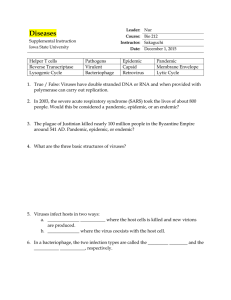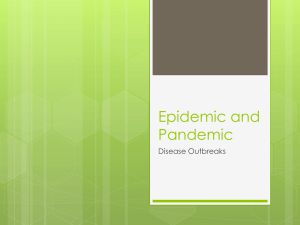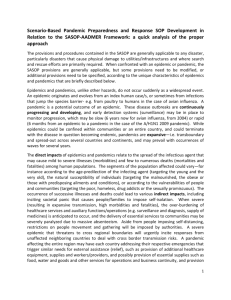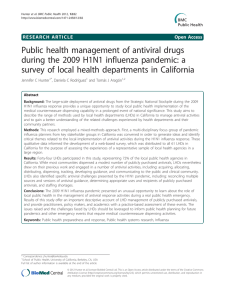Pandemic Influenza Modelling
advertisement
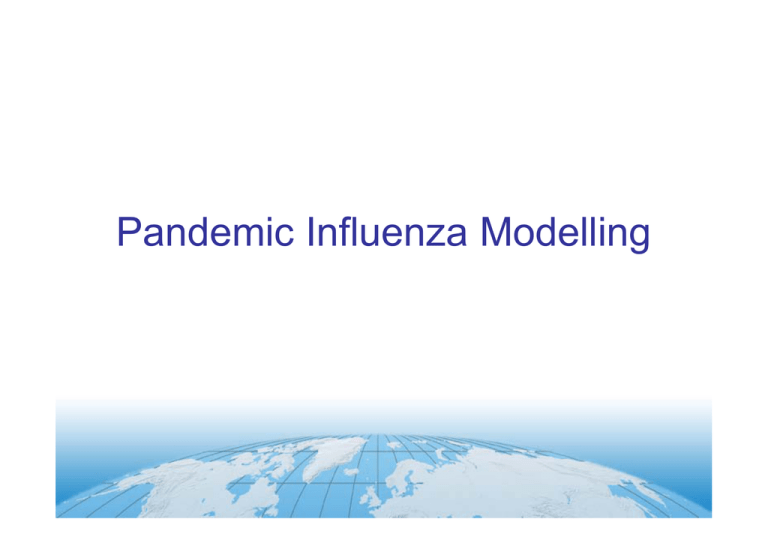
Pandemic Influenza Modelling ‘Modelling’ can be used to describe many diverse activities Construct a simplified or idealised version, the ‘model’ The model can then be analysed in detail, often using mathematical techniques Depending on the questions being asked different simplifications will be appropriate Many different models are usually required to capture the different aspects of a complicated problem Knowledge of how a model fails to capture all the aspects of the real situation is often as important as the model itself Two kinds of model are being studied in planning responses to a Flu Pandemic – Epidemiological models considering how the disease will spread and the effectiveness of countermeasures – ‘Operational’ models looking at the mechanics of how countermeasures can be implemented Modelling can only be as good as the data fed into the models and the assumptions made in the design In the case of dealing with a new pandemic flu virus there is little data and a wide range in the plausible assumptions The role of modelling is thus: to map out the range of possible risks and to suggest which responses are robust over the range of uncertainty Groups Health Protection Agency – Centre for Infections – Centre for Emergency Preparedness and Response Department of Infectious Disease Epidemiology, Imperial College London SAT/ESOR Others (e.g. ICS) Work areas Characteristics of a UK epidemic of pandemic flu without intervention (Health impact assessments) The possibilities of containment of a pandemic outside the UK and slowing/preventing subsequent arrival in the UK Antiviral use within the UK (both in treatment and possible containment) Other pre-vaccination public health measures Vaccination strategies in the UK NHS ‘surge’ capacity Health Impact Assessment Base scenario Cumulative clinical attack rate of 25% of the population over one or more waves, around 15 weeks each, weeks or months apart ‘Worst case’ of single wave with 25% attack rate Overall case fatality rate of 0.37% (based on inter-pandemic and 1957 experience) Hospitalisation rate of 0.55% (based on inter-pandemic experience) Targeted antiviral prophylaxis and local travel restrictions might contain an outbreak in South East Asia. • Antiviral prophylaxis combined with social distance measures is capable of containing the earliest stage of a pandemic providing: • • • • The original cluster is identified rapidly. Treatment can be delivered rapidly. Enough courses of drug are available – 3m+. Case detection is good once first cluster is identified. Neil M. Ferguson, Derek A.T. Cummings, Simon Cauchemez, Christophe Fraser1, Steven Riley, Aronrag Meeyai1, Sopon Iamsirithaworn & Donald S. Burke – Nature 437(7056) pages 209-214 Travel restrictions (1) Effect in delaying UK epidemic Restrictions into UK only – 90% effective ban – 99% effective ban – 99.9% effective ban 1 to 2 weeks 3 to 4 weeks 1 to 2 months International restrictions from all countries with epidemics – 90% effective ban – 99% effective ban – 99.9% effective ban 3 to 4 weeks 7 to 8 weeks 3 to 4 months Travel restrictions (2) Pandemic flu would probably take about a month to build up from a few to around a thousand cases and then perhaps only 2 to 4 weeks to spread from Asia to the UK Imposing a 90% restriction on air travel would delay the peak of a pandemic wave by only 1 to 2 weeks. On the other hand a 99.9% travel restriction might delay a pandemic wave by 2 months Travel restrictions (3) If a substantial seasonal effect on the transmissibility of pandemic flu it might, theoretically, be possible to “buy” enough time to shift what would otherwise have been a winter outbreak to the spring (or a spring outbreak to the summer), when the lower transmissibility would result in a smaller outbreak Assuming passengers are screened before travel for clinical symptoms, there is little additional advantage in entry screening Antiviral use within UK Antivirals are most efficiently used for treatment. If the available stock is less than the clinical attack rate it will be necessary to limit treatment to priority groups Although the main purpose of antiviral treatment is to reduce the severity of the disease, treating all clinical cases with antivirals might also decrease the overall attack rate There is considerable uncertainty as to the extent of the reduction possible. Some models suggest a reduction of up to one third Pre-Vaccination Public Health Measures Even very substantial restrictions on travel within the UK (~60%) would delay the peak of an epidemic only by of the order of a week, make little difference to the total numbers of cases and reduce the peak incidence by at most 5-10%. Closing schools and other educational facilities would have a limited effect on the epidemic. There would be a major reduction in the numbers of students affected. On the other hand, there would be little reduction in the number of cases in the rest of the population. There is little evidence that cancelling large public events would have any significant impact on the course of the epidemic. In progress Targeting of vaccination – Priority driven by at risk groups? – Interrupting transmission? Health care capacity – Surge capacity – Absenteeism – Delivery systems Timetable Characteristics of a UK epidemic of pandemic flu without intervention (Health impact assessments) The possibilities of containment of a pandemic outside the UK and slowing/preventing subsequent arrival in UK Antiviral use within the UK (both in treatment and possible containment) Completed Other pre-vaccination public health measures – Main results completed. Some refinement on school closures before end of year Vaccination strategies in the UK Health care capacity – Scoping work underway. Completed by end 2005 To be revisited Use of travel restrictions with seasonality to delay UK epidemic by a season (say 6 months) Use of antivirals to mitigate epidemic if it were known significant vaccine stocks would arrive in a timescale of 3 to 4 months

